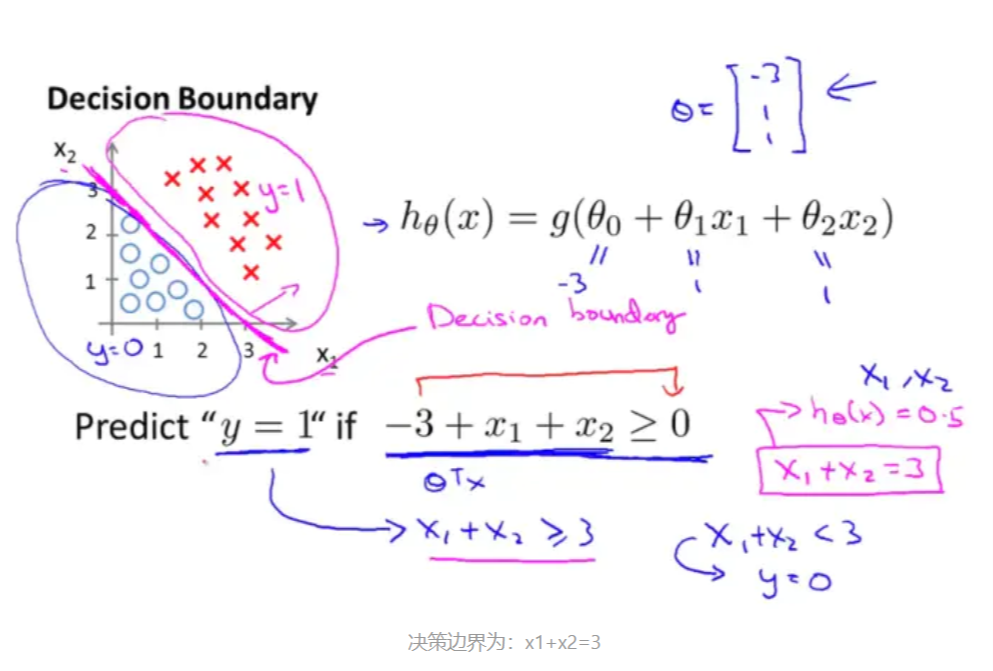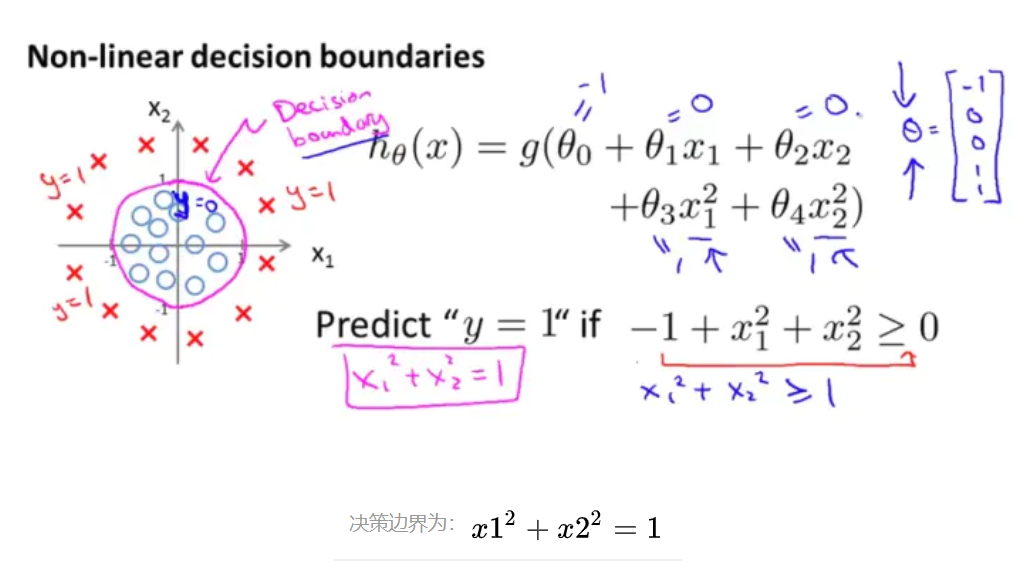二分类模型之logistic
liner classifiers
逻辑回归用在2分类问题上居多。它是一个非线性的回归模型,其最大的好处恰恰是可以解决二元类问题,目前在金融行业,基本都是使用Logistic回归来预判一个用户是否为好客户,因为它还弥补了其他黑盒模型(SVM、神经网络、随机森林等)不具解释性的缺点。知乎
1.logistic
- 逻辑回归其实是一个分类算法而不是回归算法。通常是利用已知的自变量来预测一个离散型因变量的值(像二进制值0/1,是/否,真/假)。简单来说,它就是通过拟合一个逻辑函数(logit fuction)来预测一个事件发生的概率。所以它预测的是一个概率值,自然,它的输出值应该在0到1之间。--计算的是单个输出
1.2 sigmoid
逻辑函数
\(g(z)=\frac{1}{1+e^{-z}}\)

- sigmoid函数是一个s形的曲线,它的取值在[0, 1]之间,在远离0的地方函数的值会很快接近0或者1。它的这个特性对于解决二分类问题十分重要
- 二分类中,输出y的取值只能为0或者1,所以在线性回归的假设函数外包裹一层Sigmoid函数,使之取值范围属于(0,1),完成了从值到概率的转换。逻辑回归的假设函数形式如下
\(h_{\theta}(x)=g\left(\theta^{T} x\right)=\frac{1}{1+e^{-\theta^{T} x}}=P(y=1 | x ; \theta)\)
则若\(P(y=1 | x ; \theta)=0.7\),则表示输入为x的时候,y=1的概率为0.7
1.3 决策边界
决策边界,也称为决策面,是用于在N维空间,将不同类别样本分开的直线或曲线,平面或曲面
根据以上假设函数表示概率,我们可以推得
if \(h_{\theta}(x) \geqslant 0.5 \Rightarrow y=1\)
if \(h_{\theta}(x)<0.5 \Rightarrow y=0\)
1.3.1 线性决策边界

1.3.2 非线性决策边界

1.4 代价函数/损失函数
在线性回归中的代价函数为
\(J(\theta)=\frac{1}{2 m} \sum_{i=1}^{m}\left(h_{\theta}\left(x^{(i)}\right)-y^{(i)}\right)^{2}\)
- 因为它是一个凸函数,所以可用梯度下降直接求解,局部最小值即全局最小值
- 只有把函数是或者转化为凸函数,才能使用梯度下降法进行求导哦
- 在逻辑回归中,\(h_{\theta }(x)\)是一个复杂的非线性函数,属于非凸函数,直接使用梯度下降会陷入局部最小值中。类似于线性回归,逻辑回归的\(J(\theta )\)的具体求解过程如下
- 对于输入x,分类结果为类别1和类别0的概率分别为:
\(P(y=1 | x ; \theta)=h(x) ; \quad P(y=0 | x ; \theta)=1-h(x)\) - 因此化简为一个式子可以写为
\(\left.P(y | x ; \theta)=(h(x))^{y}(1-h(x))^{(} 1-y\right)\)
1.4.1 似然函数
\(\begin{aligned} L(\theta) &=\prod_{i=1}^{m} P\left(y^{(i)} | x^{(i)} ; \theta\right) \\ &=\prod_{i=1}^{m}\left(h_{\theta}\left(x^{(i)}\right)\right)^{y^{(0)}}\left(1-h_{\theta}\left(x^{(i)}\right)\right)^{1-y^{(i)}} \end{aligned}\)
似然函数取对数之后
\(\begin{aligned} l(\theta) &=\log L(\theta) \\ &=\sum_{i=1}^{m}\left(y^{(i)} \log h_{\theta}\left(x^{(i)}\right)+\left(1-y^{(i)}\right) \log \left(1-h_{\theta}\left(x^{(i)}\right)\right)\right) \end{aligned}\)
- 根据最大似然估计,需要使用梯度上升法求最大值,因此,为例能够使用梯度下降法,需要将代价函数构造成为凸函数
因此
\(J(\theta )=-\frac{1}{m} l(\theta )\)
此时可以使用梯度下降求解了 - \(\theta_{j}\)更新过程为
\(\theta_{j}:=\theta_{j}-\alpha \frac{\partial}{\partial \theta_{j}} J(\theta)\)
中间求导过程省略
\(\theta_{j}:=\theta_{j}-\alpha \frac{1}{m} \sum_{i=1}^{m}\left(h_{\theta}\left(\mathrm{x}^{(i)}\right)-y^{(i)}\right) x_{j}^{(i)}, \quad(j=0 \ldots n)\)
1.5正则化
损失函数中增加惩罚项:参数值越大惩罚越大–>让算法去尽量减少参数值
损失函数 \(J(β)\)的简写形式:
\(J(\beta)=\frac{1}{m} \sum_{i=1}^{m} \cos (y, \beta)+\frac{\lambda}{2 m} \sum_{j=1}^{n} \beta_{j}^{2}\)
- 当模型参数 β 过多时,损失函数会很大,算法要努力减少 β 参数值来让损失函数最小。
- λ 正则项重要参数,λ 越大惩罚越厉害,模型越欠拟合,反之则倾向过拟合
1.5.1 lasso
l1正则化
\(J(\beta)=\frac{1}{m} \sum_{i=1}^{\mathrm{m}} \cos t(y, \beta)+\frac{\lambda}{2 m} \sum_{j=1}^{n}\left|\beta_{j}\right|\)
1.5.2 ridge
l2正则化
\(J(\beta)=\frac{1}{m} \sum_{i=1}^{\mathrm{m}} \cos t(y, \beta)+\frac{\lambda}{2 m} \sum_{j=1}^{n} \beta_{j}^{2}\)
1.6 python实现
class sklearn.linear_model.LogisticRegression(penalty='l2', dual=False, tol=0.0001, C=1.0, fit_intercept=True, intercept_scaling=1, class_weight=None, random_state=None, solver='lbfgs', max_iter=100, multi_class='auto', verbose=0, warm_start=False, n_jobs=None, l1_ratio=None
1.6.1 参数
- penalty:{‘l1’, ‘l2’, ‘elasticnet’, ‘none’}, default=’l2’ 正则项,默认是l2
- The ‘newton-cg’, ‘sag’ and ‘lbfgs’ solvers support only l2 penalties. ‘elasticnet’ is only supported by the ‘saga’ solver. If ‘none’ (not supported by the liblinear solver), no regularization is applied.LogisticRegression
- dual:bool, default=False
-Dual formulation is only implemented for l2 penalty with liblinear solver. Prefer dual=False when n_samples > n_features,一般情况下是false - tol:float, default=1e-4 阈值,迭代终止条件按
- C:float, default=1.0
- Inverse of regularization strength; must be a positive float. Like in support vector machines, smaller values specify stronger regularization,正则化强度的倒数;必须是正浮点数。与支持向量机一样,较小的值指定更强的正则化
-solver:{‘newton-cg’, ‘lbfgs’, ‘liblinear’, ‘sag’, ‘saga’}, default=’lbfgs’ - Algorithm to use in the optimization problem.
- For small datasets, ‘liblinear’ is a good choice, whereas ‘sag’ and ‘saga’ are faster for large ones.
- For multiclass problems, only ‘newton-cg’, ‘sag’, ‘saga’ and ‘lbfgs’ handle multinomial loss; ‘liblinear’ is limited to one-versus-rest schemes.
- ‘newton-cg’, ‘lbfgs’, ‘sag’ and ‘saga’ handle L2 or no penalty
- ‘liblinear’ and ‘saga’ also handle L1 penalty
- ‘saga’ also supports ‘elasticnet’ penalty
- ‘liblinear’ does not support setting penalty='none'
- Inverse of regularization strength; must be a positive float. Like in support vector machines, smaller values specify stronger regularization,正则化强度的倒数;必须是正浮点数。与支持向量机一样,较小的值指定更强的正则化
- multi_class:{‘auto’, ‘ovr’, ‘multinomial’}, default=’auto’ 这个参数是多元分类中用到的,二分类中不涉及
- If the option chosen is ‘ovr’, then a binary problem is fit for each label.
- For ‘multinomial’ the loss minimised is the multinomial loss fit across the entire probability distribution, even when the data is binary. **‘multinomial’ is unavailable when solver=’liblinear’. **
-‘auto’ selects ‘ovr’ if the data is binary, or if solver=’liblinear’, and otherwise selects ‘multinomial’.
1.6.1 属性
- classes_:ndarray of shape (n_classes, )属性数组
A list of class labels known to the classifier. - coef_:ndarray of shape (1, n_features) or (n_classes, n_features)属性和特征分类的数组
- Coefficient of the features in the decision function.
- coef_ is of shape (1, n_features) when the given problem is binary. In particular, when multi_class='multinomial', coef_ corresponds to outcome 1 (True) and -coef_ corresponds to outcome 0 (False).
- intercept_:ndarray of shape (1,) or (n_classes,)
Intercept (a.k.a. bias) added to the decision function.
If fit_intercept is set to False, the intercept is set to zero. intercept_ is of shape (1,) when the given problem is binary. In particular, when multi_class='multinomial', intercept_ corresponds to outcome 1 (True) and -intercept_ corresponds to outcome 0 (False).
n_iter_:ndarray of shape (n_classes,) or (1, )
Actual number of iterations for all classes. If binary or multinomial, it returns only 1 element. For liblinear solver, only the maximum number of iteration across all classes is given.
# Create LogisticRegression object and fitlr = LogisticRegression(C=C_value)lr.fit(X_train, y_train)# Evaluate error rates and append to liststrain_errs.append( 1.0 - lr.score(X_train, y_train) )valid_errs.append( 1.0 - lr.score(X_valid, y_valid) )# Plot resultsplt.semilogx(C_values, train_errs, C_values, valid_errs)plt.legend(("train", "validation"))plt.show()

二分类模型之logistic的更多相关文章
- 【AUC】二分类模型的评价指标ROC Curve
AUC是指:从一堆样本中随机抽一个,抽到正样本的概率比抽到负样本的概率大的可能性! AUC是一个模型评价指标,只能用于二分类模型的评价,对于二分类模型,还有很多其他评价指标,比如logloss,acc ...
- Logistic回归二分类Winner or Losser----台大李宏毅机器学习作业二(HW2)
一.作业说明 给定训练集spam_train.csv,要求根据每个ID各种属性值来判断该ID对应角色是Winner还是Losser(0.1分类). 训练集介绍: (1)CSV文件,大小为4000行X5 ...
- 逻辑回归(Logistic Regression)二分类原理及python实现
本文目录: 1. sigmoid function (logistic function) 2. 逻辑回归二分类模型 3. 神经网络做二分类问题 4. python实现神经网络做二分类问题 1. si ...
- Kaggle实战之二分类问题
0. 前言 1. MNIST 数据集 2. 二分类器 3. 效果评测 4. 多分类器与误差分析 5. Kaggle 实战 0. 前言 "尽管新技术新算法层出不穷,但是掌握好基础算法就能解决手 ...
- 分类模型的性能评价指标(Classification Model Performance Evaluation Metric)
二分类模型的预测结果分为四种情况(正类为1,反类为0): TP(True Positive):预测为正类,且预测正确(真实为1,预测也为1) FP(False Positive):预测为正类,但预测错 ...
- matlab 实现感知机线性二分类算法(Perceptron)
感知机是简单的线性分类模型 ,是二分类模型.其间用到随机梯度下降方法进行权值更新.参考他人代码,用matlab实现总结下. 权值求解过程通过Perceptron.m函数完成 function W = ...
- NLP(二十)利用BERT实现文本二分类
在我们进行事件抽取的时候,我们需要触发词来确定是否属于某个特定的事件类型,比如我们以政治上的出访类事件为例,这类事件往往会出现"访问"这个词语,但是仅仅通过"访问&q ...
- NLP(二十二)利用ALBERT实现文本二分类
在文章NLP(二十)利用BERT实现文本二分类中,笔者介绍了如何使用BERT来实现文本二分类功能,以判别是否属于出访类事件为例子.但是呢,利用BERT在做模型预测的时候存在预测时间较长的问题.因此 ...
- keras框架下的深度学习(二)二分类和多分类问题
本文第一部分是对数据处理中one-hot编码的讲解,第二部分是对二分类模型的代码讲解,其模型的建立以及训练过程与上篇文章一样:在最后我们将训练好的模型保存下来,再用自己的数据放入保存下来的模型中进行分 ...
随机推荐
- const与vector的搭配
有三种组合方式,分别为: vector<const int> vec; const vector<int> vec; const vector<const int> ...
- javascript 动态加载javascript文件
/* loadFile(data, callback): 动态加载js文件 data: 存放需要加载的js文件的url("url" || ["url", &qu ...
- Danganronpa 水题。
Danganronpa Time Limit: 2000/1000 MS (Java/Others) Memory Limit: 65536/65536 K (Java/Others)Total ...
- 【算法总结】图论/dp-动态规划 大总结
写于一只蹲在角落的蒟蒻-Z__X... 2020.2.7,图论和 \(dp\) 终于告一段落.蓦然回首,好似已走过许多...不曾细细品味,太多太多又绵延不断地向我涌来... 谨以此纪念 逝去 的图论和 ...
- 寒假答辩作品——掘地求升C语言版
寒假答辩—掘地求升(C语言版) 前言 这个是作为寒假答辩作品写的. 之前考虑过用Unity写个游戏,但毕竟不熟悉C#,感觉几乎都是在套模板,而且写着不顺手,有想法却只能 看着C#发呆,很是无奈,所以决 ...
- RJM8L151F6P6温度枪方案对比
疫情当下,温度计.呼吸机.监护仪.制氧机等医疗产品的生产供应至关重要,红外温度计属于非接触式测温,它是利用物体热辐射与物体温度之间的关系来工作的. 红外测温仪是一种将红外技术与微电子技术相结合的新型温 ...
- 解决掉你心中 js function与Function的关系的疑问
前言 在网上有很多关于js function 与 Function直接关系的文章. 但是我感觉过于抽象化了,那么如何是具体化的解释? 正文部分为个人理解部分,如有不对望指出. 正文 <scrip ...
- DOTNET Core MVC (一)
以控台的形式,运行.net core mvc 代码, Host.CreateDefaultBuilder(args) .ConfigureWebHostDefaults(webBuilder => ...
- 初窥ECharts
近来趁着空闲时间了解了一下 ECharts.也顺带记录一番. 首先要从下载ECharts库,这个从官网可以直接下载. 引入ECharts.JS <head> <meta charse ...
- MySQL中使用group by 是总是出现1055的错误
因为在MySQL中使用group by 是总是出现1055的错误,这就导致了必须去查看是什么原因了,查询了相关的资料,现在将笔记记录下来,以便后面可以参考使用: sql_mode:简而言之就是:它定义 ...
